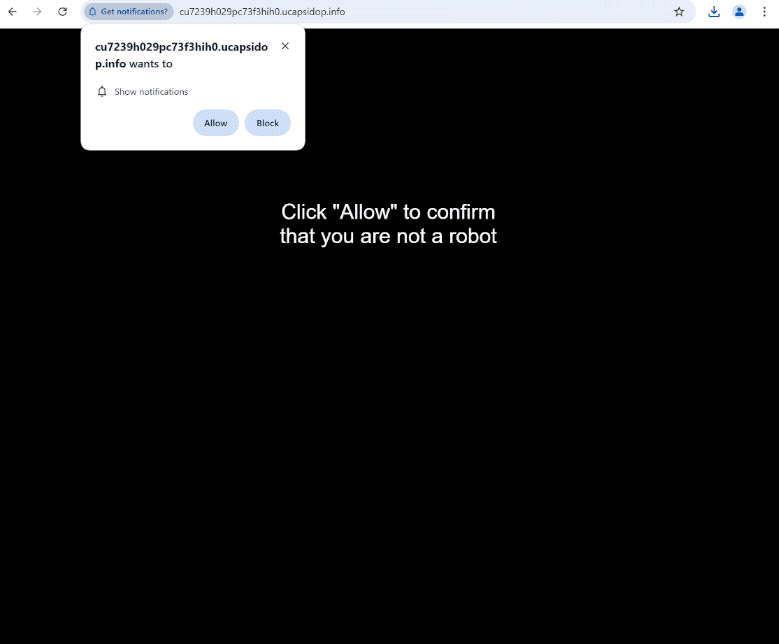Remove ucapsidop.info notifications
ucapsidop.info is a scam website that intends to trick users into allowing desktop ads. When you get redirected to the site, you will immediately get a browser alert saying “ucapsidop.info wants to show notifications”, and if you click “Allow”, you’ll authorize the site to show you ads on the desktop. These ads could expose you to potentially dangerous content, including malware and scams.
If you find yourself redirected to ucapsidop.info, you’ll see a black screen and a message asking you to click “Allow” to verify that you’re not a robot. This site also triggers the browser to show the “ucapsidop.info wants to show notifications” alert. If you click “Allow,” the site will bombard you with ads on your desktop, which can quickly become very irritating as they will continually pop up on the right side of your screen. Some of these ads might also pose risks, leading you to websites that could have malware or run scams. We should also mention that these ads appear in a similar place to legitimate system notifications so it’s easy to confuse them. If you’ve given permission to this site, it’s best not to engage with the notifications and to revoke that permission as quickly as possible.
To address potential adware that might be causing these redirects, we suggest scanning your computer with WiperSoft. If adware is indeed the cause, using an anti-virus program can help you remove it easily. If you’ve allowed the site to send you push notifications, you can revoke this permission in your browser’s settings. We’ll provide step-by-step instructions at the end of this report for those who need assistance with navigating their browser’s settings.
What triggers redirects to sites like ucapsidop.info
When users visit ad-heavy websites without an ad blocker, they are often redirected to sites like ucapsidop.info. These sites typically flood visitors with ads to generate revenue. Sites that have adult or pirated content are particularly notorious for doing that. Fortunately, this issue can be easily resolved with any decent adblocker program. Adblockers can effectively prevent these unwanted redirects and advertisements.
Frequent redirects might also indicate an adware infection, which usually also means a noticeable increase in regular advertisements. While adware itself isn’t considered a serious threat, it can be quite annoying. Adware and browser hijackers are often installed through a method known as software bundling. This method allows unwanted programs to be installed without the user’s explicit consent. These extra programs are typically bundled with popular free programs as optional offers, which can be installed alongside the main program. While these offers are technically optional, users need to manually uncheck them during installation to block them from installing. Unfortunately, these offers are often buried in settings that users may not check, making them easy to overlook.
It’s not difficult to prevent these unwanted installations, all you need to do is pick the right settings when installing programs. Installation windows suggest using Default settings, which allow all bundled offers to install automatically. Instead, opting for Advanced settings will reveal all additional offers, giving users the option to uncheck anything they don’t want. Accepting any of these offers can lead to a cluttered computer filled with unnecessary programs that are difficult to remove. This is why software bundling is a controversial method and many anti-virus programs flag programs that use it as potential risks.
How to stop ucapsidop.info notifications?
We highly recommend scanning your computer with an anti-virus program, such as WiperSoft, to check for any adware infections. If adware is the trigger, using anti-virus software is the most effective way to eliminate it. What’s more, install an adblocker programs.
If you’ve granted ucapsidop.info or any other unknown website permission to send you notifications, you can easily revoke that permission through your browser’s settings. Below, you’ll find instructions to help you navigate these settings. If you’d prefer not to receive notification requests in the future, you can also disable the feature entirely.
- For Mozilla Firefox: Open Menu (the three bars top-right corner) -> Options -> Privacy & Security. Scroll down to Permissions, press Settings next to Notifications, and remove ucapsidop.info and any other questionable websites. You can permanently turn off these notification requests by checking the “Block new requests asking to allow notifications” box in the same Notifications settings.
- For Google Chrome: Open Menu (the three dots top-right corner) -> Settings -> Privacy and security -> Site Settings. Click on Notifications under Permissions, and remove ucapsidop.info and any other questionable websites. You can stop these notification requests permanently by toggling off “Sites can ask to send notifications”.
- For Microsoft Edge: Open Menu (the three dots top-right corner) -> Settings -> Cookies and site permissions -> Notifications. Review which sites have permission and remove ucapsidop.info and any other questionable websites. You can permanently turn off these notification requests by toggling off “Ask before sending”.
Site Disclaimer
WiperSoft.com is not sponsored, affiliated, linked to or owned by malware developers or distributors that are referred to in this article. The article does NOT endorse or promote malicious programs. The intention behind it is to present useful information that will help users to detect and eliminate malware from their computer by using WiperSoft and/or the manual removal guide.
The article should only be used for educational purposes. If you follow the instructions provided in the article, you agree to be bound by this disclaimer. We do not guarantee that the article will aid you in completely removing the malware from your PC. Malicious programs are constantly developing, which is why it is not always easy or possible to clean the computer by using only the manual removal guide.

